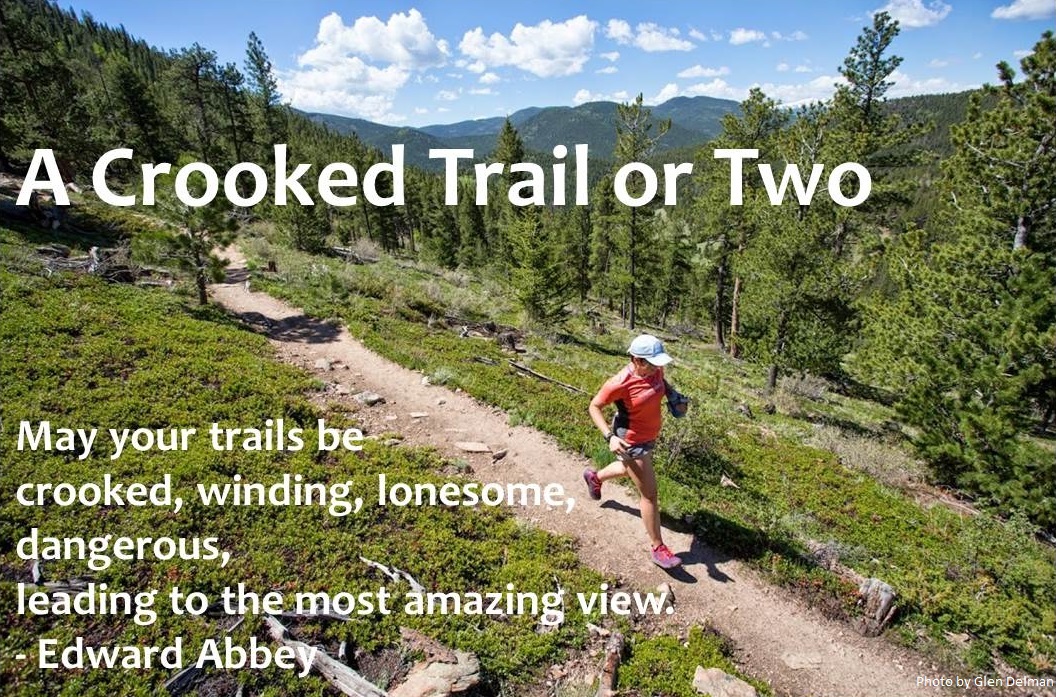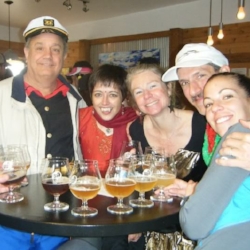The Joy of Movement
I feel a little sheepish about sharing this, because I don't run to attract attention to myself, but I was very honored recently when a CSU student, Kendall Greenwood, asked to write a story about my HURT 100 finish. It was a lot of fun talking with her and she did a great job, so I thought I'd share her story here (including a link to the story on CSU's site, for however long that might remain active).
Also, I figured letting her write the story might give me a chance to offer a little hope to anyone out there enduring the pain of rheumatoid arthritis or some other autoimmune disease: people who might be wondering if they'll ever be able to lead active lives again. I was very fortunate indeed that my treatment was effective, but I'm here as an example of at least one person whose RA went into remission. Perhaps yours will too!
I also hope that anyone who reads the article can discover that you don't have to win the race to love running. The journey -- all those hours of training -- can be as joyful as the finish.
So...enjoy Kendall's story, friends, and I'll see you on the trail!
The joy of movement
February 28, 2011, by Kendall Greenwood.
Photo: Andrea Stout '96
In January, Ashley Waddell, assistant director of development in the College of Engineering, finished the fifth and final loop of the Hawaiian Ultra Running Team's H.U.R.T. 100-Mile Endurance Run as the sixth woman to cross the finish line. Not bad for somebody who was diagnosed with rheumatoid arthritis in 1998.
Running in paradise
“When I first got sick, my joints were so inflamed I couldn’t dress myself,” Waddell says. She underwent aggressive treatment and the disease went into remission in 2000. She’s been running ever since.
The 100-mile race winds around a 20-mile loop on rugged, muddy trails in Honolulu. Runners must run the loop five times and within 36 hours to complete the race. This year, 111 runners started, and only 35 finished. Waddell completed the race in 35 hours, 18 minutes.
Waddell’s training partner, Sarah McIntosh, convinced her to sign up for the ultra-marathon. McIntosh had run the race a few times and recommended it. “I thought well, what’s the harm?” Waddell says. “I’ll sign up for it but I probably won’t get chosen.”
Not the only race
The Hawaiian H.U.R.T. is not the only race Waddell has been in. She ran track in junior high for the enjoyment of the run, but realized her passion for running longer distances after her first marathon. In 2006, Waddell ran the Catalina Marathon on Catalina Island.
“In the course of that race, I realized that I finished it feeling like I could go farther,” Waddell says. “That’s when I started looking into ultra-marathons.”
John Waddell, a support scientist for the National Center for Genetic Resources Preservation and Ashley’s father, was not completely surprised when he heard his daughter had been accepted to run the 100-mile race. As he puts it, Ashley is always surprising him, and it didn’t seem like a far stretch for her because she had already completed a 50-mile race.
Training at home
To train for the H.U.R.T. 100, Waddell and McIntosh figured out a trail run in the foothills outside Fort Collins that closely approximated the 20-mile loop, conditions and all, that they would run in Honolulu. They were careful to simulate the 5,500 feet of elevation gained per loop.
The training schedule included one long run of at least 20 miles (and often more) once a week, usually Fridays. The day after, Waddell and McIntosh would run a shorter distance of 10 or 20 miles. During the week, Waddell would add two or three other runs to her schedule.
“The idea was to experience all that climbing and get our bodies used to running on tired legs,” Waddell says.
She worked her expansive and exhausting training schedule into her regular work routine at CSU, where she’s been employed since 2008. As assistant director in the College of Engineering, she generates support for scholarships and projects for the college such as the new Engineering Building planned for construction starting in April.
In a sense, she’s been a member of the University community most of her life. “My mom worked in the art department when I was a little kid, so I used to roller skate around the art building,” Waddell says.
It takes a family
Her family was supportive and helped her get through months of training, but, “I couldn’t have done this without my partner, Christi Brockway,” Waddell says. “If she hadn’t been so supportive, it just wouldn’t have worked.”
To support and inspire herself, Waddell reminded herself how lucky she was to be in the race. She could not run for two years after being diagnosed with rheumatoid arthritis. “I just feel so lucky I’m able to run every day,” Waddell says. “It kind of keeps everything in perspective.”
When Waddell and McIntosh began the race in Hawaii, Waddell was exposed to the kind of rugged terrain she would have to endure, such as tree roots coming up to her knees. McIntosh suffered from terrible motion sickness after two-and-a-half loops and was not able to finish. For many ultra-marathon runners, even those who are strong and well trained, it’s a common problem.
Finish line
During the 35 hours of the race, Waddell stopped to rest only once when she needed to tape a blister. Volunteers ran with her, and throughout the night, fellow runners cheered each other on through the final loop.
“I felt really tired (during the fifth loop), but it was starting to occur to me that I was actually gonna finish, and that was not something that I necessarily expected going into the race,” Waddell says. “I was so happy that I didn’t really care how tired I was.”
Although she enjoyed her success in the race, another 100-mile race is not in her immediate future. She’s pursuing other unofficial endurance adventures, though, such as running the Grand Canyon nonstop from one rim to the other and back again. Waddell hopes to take on that challenge in September.




